American post-war anti-aircraft artillery. 1-Part I
After the end of World War II, the American armed forces got a significant number of medium and large caliber anti-aircraft guns, small-caliber anti-aircraft guns and machine-gun mounts. If in navy the role of anti-aircraft artillery remained for a long time, since medium-sized marine universal anti-aircraft artillery and small-caliber anti-aircraft guns were the last barrier in the way of enemy aircraft, the U.S. Army and the Marine Corps hastened to abandon most of the anti-aircraft guns. This primarily concerned medium and large-caliber guns and towed 40-mm anti-aircraft guns. After the war ended, about half of the anti-aircraft batteries were reduced, the towed guns went to storage bases, and stationary positions were mothballed. The anti-aircraft units deployed in the United States were mainly reduced, due to the fact that until the mid-50s, there were no bombers in the USSR capable of performing a combat mission on the continental part of America and returning back. In the 50s, jet fighter jets appeared, whose flight speed at high altitudes became about twice that of what the fastest piston airplanes developed. The creation of anti-aircraft missiles, capable of shooting down high-altitude bombers with a high probability, further reduced the role of large-caliber anti-aircraft guns.
However, the US military was not going to finally abandon anti-aircraft artillery. It is worth saying that during the war years in the USA very effective anti-aircraft systems and fire control devices were created. In the 1942 year, taking into account the operating experience of previous models, the 90-mm M2 anti-aircraft gun was launched. Unlike earlier guns of the same caliber, the new anti-aircraft gun could lower the barrel below 0 °, which allowed it to be used in coastal defense and to fight enemy armored vehicles. The device of the gun made it possible to use it also for firing at ground mobile and stationary targets. The maximum firing range of the 19000 M made it an effective counter-battery weapon. Compared to the 90-mm МNNXXА1 anti-aircraft gun, the construction of the bed became much simpler, which led to a reduction in weight on the 1 kg and many times reduced the time to bring the M2000 into a combat position. A number of fundamental innovations were introduced into the design of the gun, the M2 model received an automatic projectile feed with a fuze installer and rammer. Due to this, the installation of the fuse has become faster and more accurate, and the rate of fire has increased to 2 shots per minute. But the weapon became even more effective in 28, with the adoption of a projectile with a radio fuse. 1944-mm anti-aircraft guns were usually reduced to 90-gun batteries, from the second half of the war they were attached to fire detection and control radars.
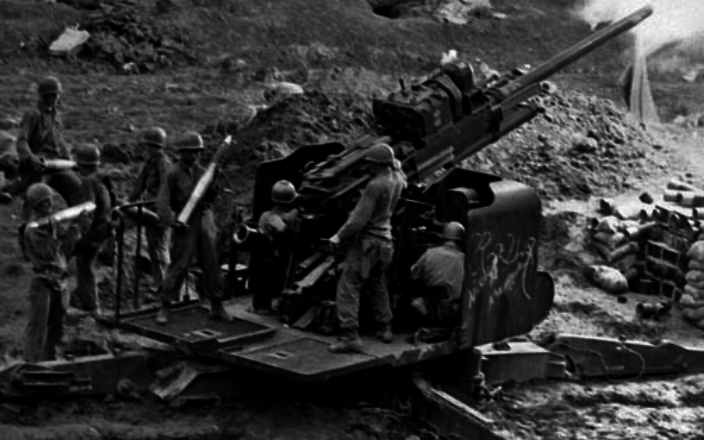
Correction of anti-aircraft battery fire was carried out using radar SCR-268. The station could see the planes at a distance of up to 36 km, with an accuracy in the range of 180 m and in azimuth 1,1 °. This was especially important in repelling enemy raids at night. 90-mm anti-aircraft guns, guided by radar shells with a radio fuse, were regularly shot down by German V-1 unmanned aerial vehicles over South England.
By the end of the 1945 fighting, the American industry had produced almost 8000 90-mm anti-aircraft guns of various modifications. Some of them were installed at stationary positions in special armored towers, mainly in areas of naval bases and around major administrative and industrial centers on the coast. It was even proposed to supply them with automatic loaders and ammunition supplies, as a result of which there was no need for gun crews, since the guidance and firing could be controlled remotely. According to American documents, the 25 90-mm anti-aircraft guns equipped with the SCR-268 radars were sent by Lend-Lease agreement in the USSR.
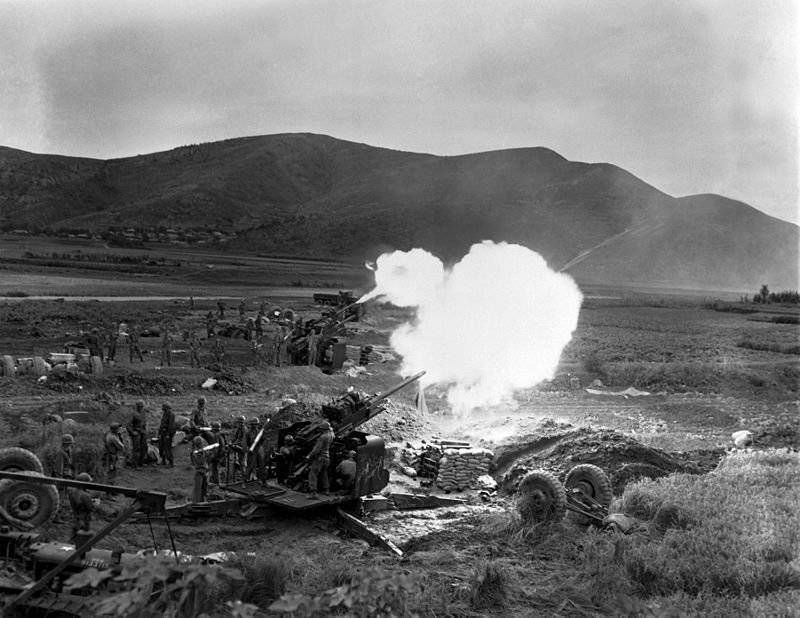
At the end of the 40-s, American 90-mm anti-aircraft batteries stationed in Europe and in Asia received new fire control radars, which allow them to more accurately adjust the fire for speed targets flying at medium and low altitudes. After the UN Force landed in Korea, the M2 anti-aircraft guns with new guidance radars took part in the hostilities. However, they hardly ever fired at North Korean planes, but these guns were very often used to provide fire support to ground units and counter battery battles. In 50-60-s, 90-mm anti-aircraft guns were transmitted in large numbers to the armed forces of US-friendly countries. For example, in a number of European NATO member countries they were exploited until the end of the 70s.
In 1943, the 120-mm M1 anti-aircraft gun was adopted in the USA. For high ballistic characteristics in the troops, it was called the "stratospheric gun." This anti-aircraft gun could hit air targets with a 21 kg projectile at heights up to 18 000 m, producing up to 12 shots / min.
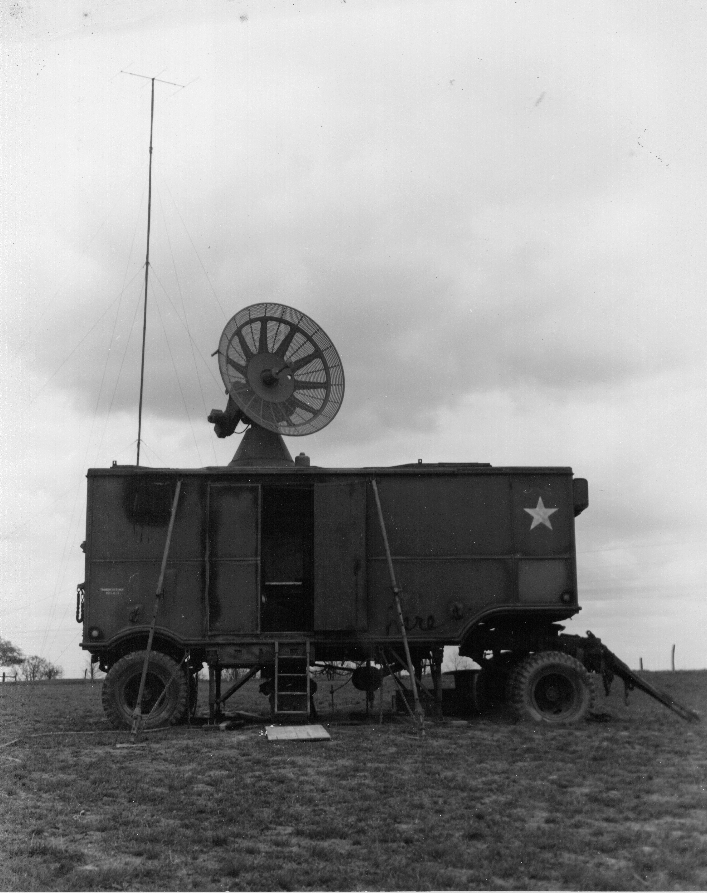
Targeting and control of anti-aircraft fire was carried out using radar SCR-584. This highly advanced 40 radar operating in the 10-cm radio frequency band could detect targets at a distance of 40 km and adjust the anti-aircraft fire at a distance of 15 km. The use of radar in combination with an analog computing device and projectiles with radio-fuses made it possible to conduct fairly accurate anti-aircraft fire on aircraft flying at night at medium and high altitudes. An important circumstance that increases the damaging effect was that the 120-mm fragmentation projectile weighed almost 2,5 times more than 90-mm. However, as is well known, the disadvantages - the continuation of the merits, with all their advantages 120-mm anti-aircraft guns were very limited mobility. The weight of the gun was impressive - 22000 kg. Transportation of the 120-mm anti-aircraft guns was carried out on a two-axle cart with twin wheels, and served its calculation from the 13 man. Travel speed even on the best roads did not exceed 25 km / h.
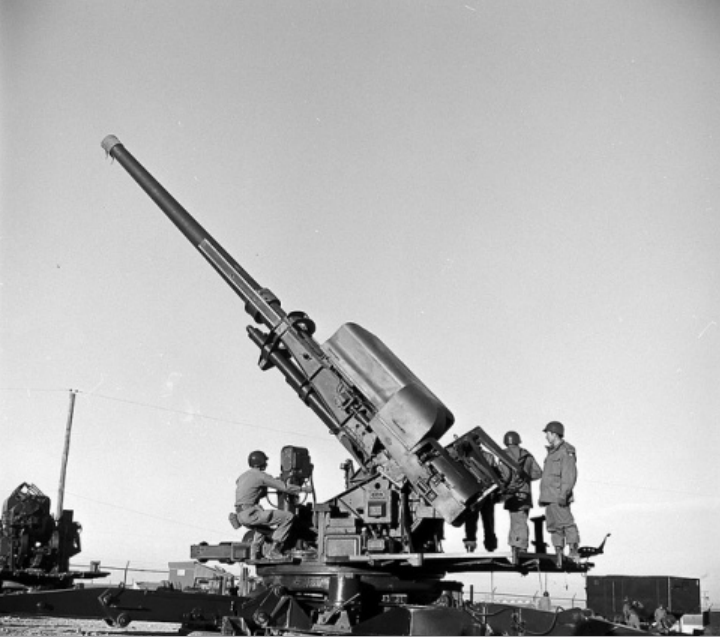
When firing, the 120-mm anti-aircraft gun was hung on three powerful supports that were lowered and raised hydraulically. After lowering the supports, the tire pressure was released for greater stability. As a rule, four-arm batteries were based near vital objects on previously prepared stationary concreted positions. During the war, 120-mm anti-aircraft guns were deployed along the American West Coast to protect against the expected Japanese air attacks, which never took place. Sixteen M1 guns were sent to the Panama Canal zone and several batteries were placed in and around London to assist in the protection of the V-1. A four-gun battery with a SCR-584 radar was sent to the Soviet Union.
Total American industry handed over to the military 550 120-mm anti-aircraft guns. Most of them never left the continental United States. These long-range and high-altitude anti-aircraft guns carried service until the beginning of the 60-s, until the Nike-Hercules MIM-14 anti-aircraft missile systems began to flow into service with army air defense units.
Due to their heavy weight, 90 and 120 mm anti-aircraft guns were most often used in object-based air defense, while the troops were usually covered by 12,7 mm anti-aircraft machine-gun mounts and small-caliber anti-aircraft guns. If the U.S. Navy relied on 20 mm Oerlikon anti-aircraft guns, then the main means of protection against aviation troops on the march in wartime were heavy 12,7 mm M2 machine guns. This machine gun was created by John Browning in 1932. The large-caliber Browning machine guns used a powerful .50 BMG cartridge (12,7 × 99 mm), which provided a 40 g bullet with an initial speed of 823 m / s. At a range of 450 m, an armor-piercing bullet of this cartridge is capable of piercing a 20 mm steel plate. As an anti-aircraft gun, a model with a bulky casing of water cooling was originally produced, weapon air-cooled barrel was intended to combat light armor and as a means of infantry support.
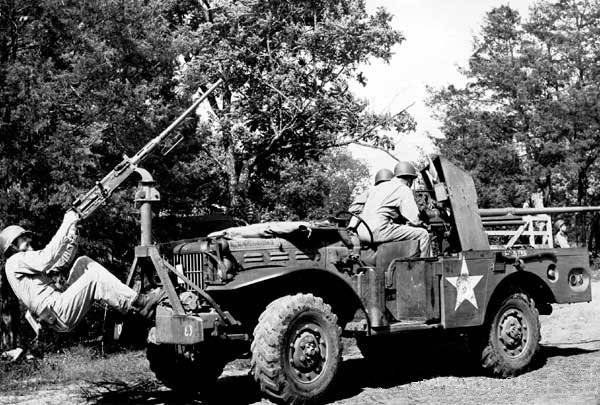
To provide the necessary intensity of fire in the air-cooled version, a heavier barrel was developed, and the machine gun was designated the Browning M2HB. The rate of fire was 450-600 shots / min. The machine gun of this modification was widely distributed and was used as an anti-aircraft gun in single, twin and quad anti-aircraft installations. The most successful was the quad installation of M45 Maxson Mount. Her weight in the fighting position was 1087 kg. The firing range of air targets is about 1000 m. The rate of fire is 2300 shots per minute.
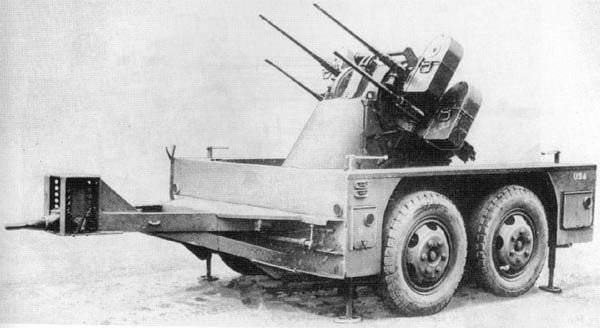
Maxson Mount SSDs, starting with the 1943 year, were produced in both towed and self-propelled versions. The towed version on the four-axle trailer was designated the M51. When translated into a firing position, special supports were lowered to the ground from each corner of the trailer to give stability to the installation. Guidance was carried out using electric drives powered by lead-acid batteries. The trailer also contained a gasoline generator to charge the batteries. The electric motors of the pointing drives were powerful, capable of withstanding the greatest loads, thanks to which the installation had a pointing speed of up to 50 ° per second.
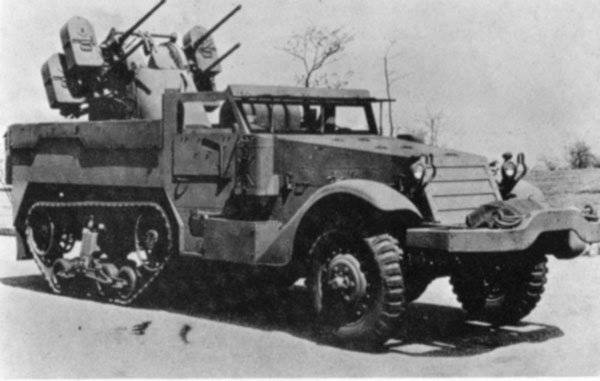
The most common in the American army ZSU with quad machine-gun installations was the M16 on the basis of the half-track BTR M3. Total 2877 released such machines. Installation Maxson Mount is usually used to guard against attack air raids of transport convoys on the march or military units in places of concentration. In addition to direct assignment, quad-mounted large-caliber machine guns were a very powerful means of fighting manpower and lightly armored vehicles, earning an unofficial nickname among the American infantrymen, the "meat grinder." They were especially effective in street battles, large elevation angles made it possible to turn attics and upper floors of buildings into sieves.
With the self-propelled self-propelled gun M16 was very similar ZSU M17, which differed with the type of conveyor. The M17 was built on the basis of the M5 armored personnel carrier, which differed from the M3 only in some units and assemblies, as well as in the hull production technology. Quad rifle installations of large-caliber machine guns in the American army were used until the end of the 60-s, until deliveries to the Vulkan ZSU troops began.
Anti-aircraft guns with large-caliber machine guns M2 proved to be a very effective means of repelling low-altitude attacks of enemy aircraft. Due to the high combat and service-performance characteristics of its time, anti-aircraft 12,7 mm machine guns are widely used in the armed forces of the United States and their allies, and are still in use today.
Shortly before the war, an 37-mm anti-aircraft machine gun developed by John Browning began to enter the army anti-aircraft units. But the military was not satisfied with an insufficiently powerful ammunition that did not provide the necessary initial velocity of the projectile, which made it difficult to defeat airplanes flying at high speed. It was at this time that the British asked the Americans to use part of their production capacity to produce the Bofors L40 60 anti-aircraft gun for the UK. Having tested the Bofors, the US military was convinced of the superiority of these anti-aircraft guns over the domestic system. A set of technological documentation, transmitted by the British, helped speed up production. In fact, the license for the production of 40-mm anti-aircraft guns in the United States was officially issued by Bofors after the start of their mass admission to the troops. The American version of the Bofors L60 received the designation - 40 mm Automatic Gun.
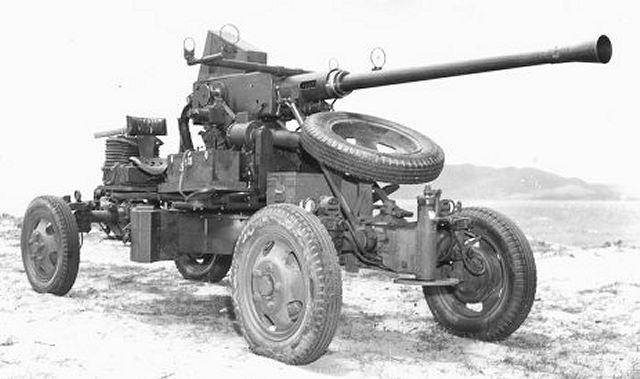
Fragmentation projectile weighing 0,9 kg left the barrel at a speed of 850 m / s. Rate of shooting about 120 rds / min. Automatic rifles on 4 shots were loaded, which were inserted manually. The gun had a practical ceiling of about 3800 m, with a range of 7000 m. As a rule, a single 40-mm fragmentation projectile hit the enemy attack aircraft or diving bomber was enough to defeat it.
The gun is mounted on a four-wheel towed "cart". In the case of urgent need, shooting could be carried out directly from the gun carriage, “from the wheels” without additional procedures, but with less accuracy. In normal mode, the frame of the carriage fell to the ground for greater stability. The transition from the “traveling” position to the “combat” position took about 1 minutes. With an anti-aircraft gun's weight of about 2000 kg, towing was carried out by truck. Calculation and ammunition while located in the back. At the end of the 40-s, most of the 40-mm anti-aircraft guns, as no longer satisfying modern requirements, were withdrawn from the army’s air defense units, they were kept in warehouses until the adoption of the Red I air defense missile system.
The big disadvantage of the 40-mm anti-aircraft gun being towed was that it could not fire immediately. In this regard, in addition to towed options, several types of 40-mm ZSU were developed. In the USA, the Bofors were mounted on modified 2,5-ton chassis of GMC trucks CCKW-353. These self-propelled units were used to support the ground forces and provide protection against air attacks without the need for a stationary installation on the ground and the deployment of the system into a combat position. Armor-piercing shells 40-mm guns could penetrate 50-mm homogeneous steel armor at a distance of 500 meters.
The experience of military operations revealed the need to have a SPAAG on a tracked chassis for escorting tank divisions. Tests of such a machine took place in the spring of 1944 at the Aberdeen Tank Range. The ZSU, which received the serial designation M19, used the chassis of the M24 Chaffee light tank and was armed with two 40-mm anti-aircraft guns installed in an open-top turret. The shooting was carried out using an electric trigger. Rotation of the turret and the swinging part of the cannons is controlled by a manual electro-hydraulic drive. The ammunition load was 352 shells.
For the middle of the 40-ies anti-aircraft self-propelled gun had good data. The car, which weighed about 18 tons, was covered with 13 mm armor, which provided protection against bullets and shrapnel. On the highway M19 accelerated to 56 km / h, the speed of movement over rough terrain was 15-20 km / h. That is, the mobility of the ZSU was on the same level with the tanks.
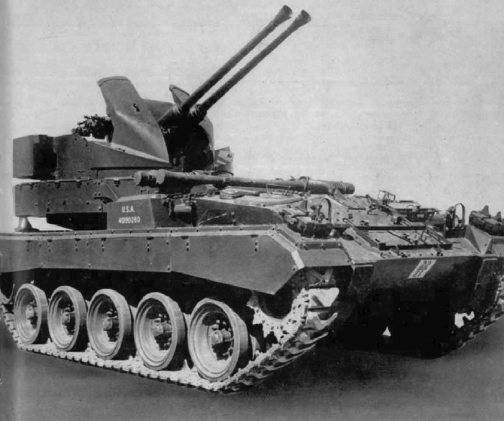
But the ZSU did not have time to go to war, as it took about a year to eliminate the "children's ills" and the establishment of mass production. They built them a little, just 285 machines, until the end of the fighting several dozen M19s were put in the troops. The twin anti-aircraft 40-mm self-propelled guns were actively used during the war in Korea for firing at ground targets. Since the ammunition was fired when firing bursts very quickly, another approximately 300 shells in cassettes were carried in special trailers. By the end of the 50-x all M19 removed from service. The least worn cars were handed over to the Allies, and the rest were scrapped. The main reason for the short service of the M19 units was the refusal of the American army from the light tanks M24, unable to fight the Soviet T-34-85. Instead, the M19 was adopted by the ZSU M42. This self-propelled installation with anti-aircraft armament, similar to the M19, was created on the basis of the light tank M41 in the 1951 year. The ZNU M42 tower was identical to the one used on the M19, only on the M19 it was installed in the center of the hull, and on the M42 behind. Compared with the previous model, the thickness of the frontal armor increased by 12 mm, and now the forehead of the hull could hold armor-piercing bullets of a large-caliber machine gun and small-caliber shells. With a 22,6 combat mass, the car could accelerate onto a highway to 72 km / h.
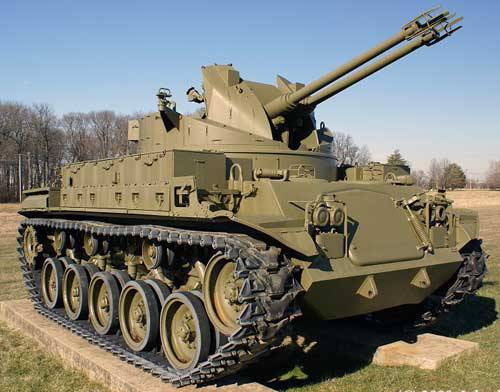
Self-propelled self-propelled gun, also known as "Duster" (born Duster), was built quite a large series and was popular among the troops. From 1951 to 1959, General Motors Corp.'s Cleveland-based Cadillac Motor Sag facility produced about 3700 installations.
Guidance is carried out using an electric drive, the tower is able to rotate by 360 ° at a speed of 40 ° per second, the angle of vertical guidance of the tool ranges from -3 to + 85 ° at a speed of 25 ° per second. If the electric drive fails, the pickup can occur manually. The fire control system included the M24 mirror sight and the M38 counting solution, which was entered manually. Compared with the M19, the ammunition charge was increased and amounted to 480 shells. The combat rate of fire when firing bursts reached 120 rounds per minute with an effective range of fire at air targets up to 5000. For self-defense, there was a machine gun with a caliber 7,62 mm.
A significant drawback of the Duster was the lack of a radar sight and a centralized fire control system of an anti-aircraft battery. All this significantly reduced the effectiveness of anti-aircraft fire. The baptism of the American M42 took place in Southeast Asia. Unexpectedly, it turned out that 40-mm twin anti-aircraft guns, protected by armor, are very effective in repelling guerrilla attacks on transport columns. In addition to escorting columns, the Dusters were actively used throughout the Vietnam War to provide fire support to ground units. By the middle of the 70-s, the M42 were mainly withdrawn from the combat units of the "first line" and replaced with the ZNU M163 with the 20-mm Vulkan anti-aircraft gun. But due to the fact that the effective range of 40-mm guns was significantly greater, in some US army units and in the National Guard 40-mm ZSU served until the middle of 80-x.
To be continued ...
Based on:
http://zonwar.ru/index.html
http://russian-tanks.com
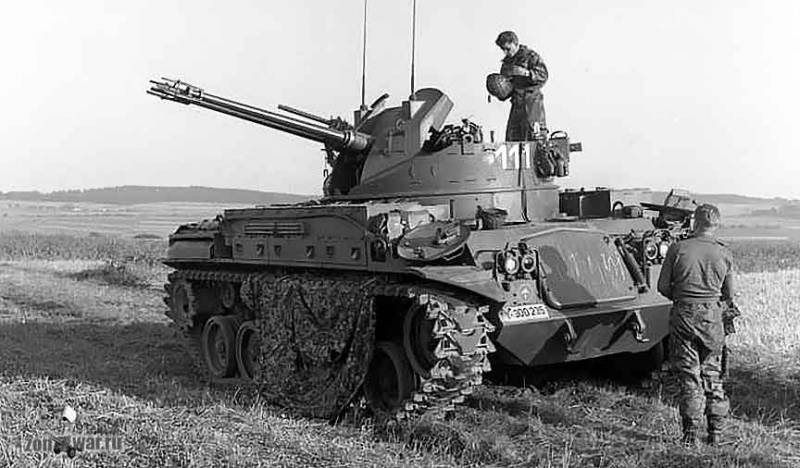
Information